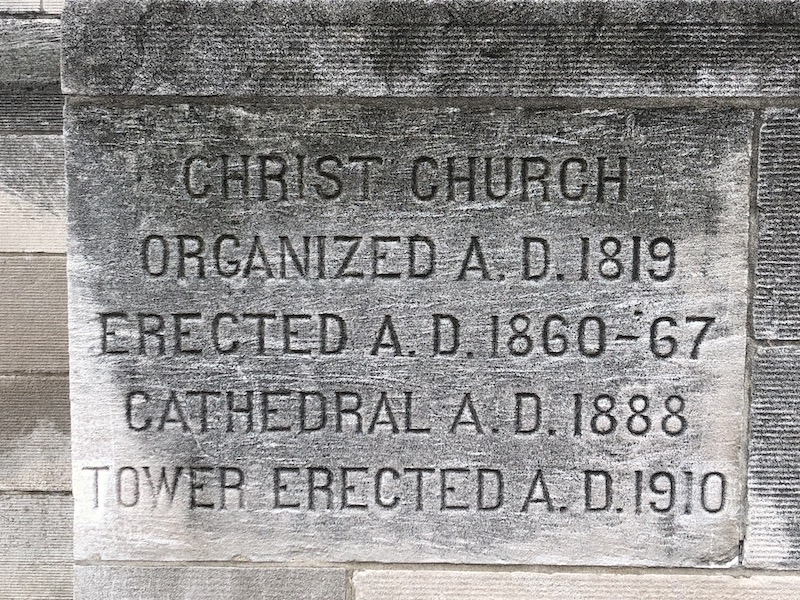The last several weeks have been a whirlwind of activity in our gospel readings. After Jesus’s triumphant entry into Jerusalem and cleansing of the Temple (which we strangely skipped over), he has entered the locus of power and engages in direct confrontation with those who would deny his authority as the son of God. This is the climax of the Gospel of Matthew, in terms of setting the final chain of events into motion, until we finally get to the Passion Narrative in later chapters.
And so this Sunday, we get the Parable of the Wicked Tenants, and the musing about rejected cornerstones. As I was looking for an image for our worship bulletin for this coming Sunday, I learned that the “chief builders” Jesus cited in his snippet from Isaiah weren’t the only ones confused about suitable cornerstones. I found images from churches that supposedly labelled all kinds of things the “cornerstone”—but instead depicting capstones on the tops of walls and keystones at the apex of arches.
Now, I am no architectural expert—but a childhood inspired by the cartoon genius of Chuck Jones taught me what a cornerstone is—besides adding in the fantasy of finding a ragtime-singing frog inside of one. Jesus tells us that the political and religious leaders of Jesus’s time, despite their reputation for being learned and wise, were just as confused when looking for the cornerstone.
Unlike the capstone or the keystone, the cornerstone was not among the last stones placed. It was the first. It had to be placed just so, so that the walls would be straight. The alignment of the whole structure was determined by the cornerstone. The choice and orientation of a cornerstone influenced the integrity of the entire building.
Jesus points out that the qualities the religious leaders are looking for in a cornerstone cause them to reject the intended stone for one that conforms to their own preconceived notions and prejudices. The intended stone instead becomes something over which they will trip and come to ruin upon. And this is not the first time a cornerstone and a stumbling block have been linked together—earlier in Matthew, Jesus renames Simon as Peter and declares he will be the cornerstone of a new group of believers. Yet a second later, Peter gets into a disagreement with Jesus, and Jesus rebukes him, warning Peter not to become a stumbling block to others.
Jesus’s claim to be the cornerstone is meant to remind us that we are being called to be new creations in Christ—opposed to the direction and orientation of a religious AND political structures, then and now, that often seek to exclude rather include, that divide as a means of power and prestige rather than seeks to unite people of all persuasions and to the glory of God. And after watching the events of the last couple of days, I wonder if anything has changed that much 2000 years after Jesus’s use of this original metaphor.
So how can we understand this metaphor for our situation now, in 21st century America in particular? Perhaps by viewing this story as being about the struggle for integrity and authority, especially against the attempted normalization of dishonesty, ruthlessness, and selfishness as the markers of an orientation toward “success.” To remember that aligning ourselves with Jesus as our cornerstone means aligning ourselves with the power of shalom– wholeness, peace, harmony, completeness, delighting in the welfare of others as the foundation of justice.
Making Jesus our cornerstone as his disciples means literal alignment with the values of the kingdom of God. How do we respond to God’s claims upon our lives? Do we line ourselves up according to God’s values of justice, mercy, and integrity? Do we give our share of the glory to God by working for the betterment of this society that we, in our freedom, have built? Do we seek to make the building and walls stronger? Or do we embrace the alignment of empire with suffering for the many for the benefit of the few, and thus become a stumbling block for those whose only understanding of God is through our own words and actions? Such a thing would be a true scandal—a word in Biblical Greek often associated with the concept of the stumbling block.
I am struck by the incongruity every morning as I pray the Venite at the start of Morning Prayer: we affirm that the Earth is the Lord’s and all that is in it, and invite each other to bend our knee in submission and reverence. Yet at the same time we are a rebellious, fractious people, who take great pride in never submitting before anyone in heaven or on Earth.
It’s enough to make one despair. We are called to counteract the griefs of the world, not surrender to them. But then, like Wendell Berry, in his beautiful poem, “The Peace of Wild Things,” I remember that “I rest in the grace of the world, and am free.” Free to choose a better cornerstone for my life, and the life of my loved ones. Free to remember that “loved ones” includes not just my family or my tribe, but calls me to open that circle wide to encompass all living things around me.
Yes, we have hope—because there are mighty cracks appearing in the walls and edifices of the empire of disdain, injustice, and exploitation. As our Presiding Bishop constantly reminds us, There IS a balm in Gilead, and it calls us to heal the wounds and build again in faith, upon the cornerstone of the Lord of Life and Love.
The Rev. Leslie Scoopmire is a writer, musician, and a priest in the Diocese of Missouri. She is rector of St. Martin’s Episcopal Church in Ellisville, MO. She posts daily prayers, meditations, and sermons at her blog Abiding In Hope, and collects spiritual writings and images at Poems, Psalms, and Prayers.

